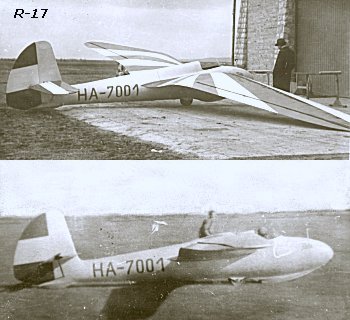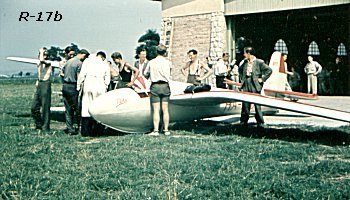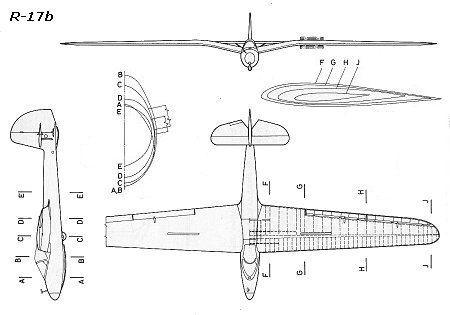HUNGARIAN
GLIDERS
1933-2000
| Type designation: |
R-17 and R-17b |
| Name: |
Móka |
| Designer: |
Ernő RUBIK |
| Class: |
aerobatic |
| General arrangement: |
Cantilever mid-gull-wing, tarditional tail unit |
| Crew: |
1 |
| First flight: |
Spring of 1944 |
| Manufacturer: |
Aero Ever Ltd., Esztergom |
| Number of built: |
3 |

.jpg)
Short history:
Ernő Rubik, part-owner of the Aero-Ever Ltd. and designer of the gliders built there, in 1937 started to design the first Hungarian aerobatic glider following the example presented by the Habicht. The glider's general arrangement reflected the requirements of aerobatics. The designer's aim was to create an agile glider with adequate strength. The new glider resembled Habicht, however the Móka had different dimensions as well as different airfoil. Another difference was the wing structure. The Móka's wing was built as a single structural unit and its fuselage did not take loads from the wing.
The prototype first flew at the spring of 1944. According to the glider's stress analysis the maximum diving speed was 520 km/h, however to prevent flutter the Vne was restricted to 400 km/h. The only problem the test flights revealed was the excessive aileron control forces at high speeds.
During the besiege of Budapest in 1945, the glider was destroyed.
After the war the design bureau headed by Ernő Rubik got a task from the newly organized Hungarian National Flying Association (OMRE) to reconstruct the drawings of the destroyed R-17 glider and modify them according to the findings of the test flights. This work was done between 1948 and 1950. The aim of redesigning the R-17 was to reduce the mass as well as to improve the handling capabilities of the glider.
The new version got the designation of R-17b and had the same main dimensions as the R-17, however got a new fuselage (of the R-22S). The production of three gliders had been started at the Sportárutermelő Vállalat (Sports Gear Factory), the legal successor of Aero Ever Ltd. The first glider first flew in the fall of 1950. During slow-speed test flights the glider performed well, however aileron flutter were experienced during high-speed tests, which had not been present with the previous version. During one of the test flights the control stick was snatched from the pilot's grip and the flight ended with crash. The test flights continued with the second glider, however one of them ended in catastrophe. When pulling up from a high-speed dive of 400 km/h, the wings had broken up because of the intensive aileron flutter and the pilot was killed.
The test flights were ended and the whole project was dropped, though eliminating the flutter would have been a possible course of action. For glider aerobatics L-107 Lunak gliders were ordered by OMRE.
Both versions were authorized for cloud flying. Within the permissible speed limits all kinds of aerobatic manoeuvres were allowed to fly.
Structure: R-17: all wooden; R-17b: wooden with light metal ailerons
Wing:
The R-17 was a mid-wing, cantilever glider. The gull wing had a trapezoid planform with elliptic wingtips. It was built as an undivided structural unit. The dihedral up to the 25 % span was 8°, from there to the wingtips -1°. The undivided slotted ailerons had differential movement with pushrod control. To reduce the landing speed the ailerons could be dropped to 5° simultaneously. This was controlled by a wheel in the cockpit. Anticipating excessive aileron control forces, aerodynamic balancing was used. To reduce diving speed a Göppingen type airbrake was fitted. The NACA 23 012 airfoil made inverted flight possible.
The wing had one main spar and at the middle section three secondary spars. Because of the undivided wing the heavy fittings necessary to connect the half wings as well as the wings and the fuselage were spared. The fuselage was hooked up to the wing by relatively light fittings.
The R-17b version's wing structure remained unchanged with a modified connection to the fuselage. Rubik-type airbrakes were used instead of Göppingen ones.
The total area of the divided, larger span, fabric covered, light metal ailerons was greater than that of the previous version. For aerodynamic balancing Frise type aileron leading edge was used. The outer panels of the divided ailerons had greater deflections as of the inner ones.
Fuselage:
The R-17's fuselage had an elliptic cross section. The cockpit was roomy and was covered with an open canopy fitted only with a windshield. The landing gear consisted of a front skid, a fixed wheel behind the c.g., and a small tail skid.
The R-17b version got a new fuselage (of the R-22S). The cross section was rounded, however the radius of the upper part at the cockpit range was smaller then that of the lower part. Behind the wing the height of the fuselage was reduced flattening out the cross section's upper part. The landing gear was similar to the one used on the R-17 version.
Tail unit:
The tail unit was traditionally arranged on both versions. The horizontal stabilizer was braced with a strut, and was foldable up to the vertical stabilizer for transportation. The rudder was cable controlled, the elevator pushrod controlled. The elevator was damped aerodynamically.


| Dimensions (R-17): |
| Wing: |
| Span, m: |
13 |
| Area, m2: |
16 |
| Aspect ratio: |
10,5 |
| Chord (root), m: |
1,7 |
| Chord (tip), m: |
0,8 |
| Airfoil (root), m: |
NACA 23012 |
| Airfoil (mid-span), m: |
NACA 23012 |
| Airfoil (tip), m: |
NACA 0009 |
| Dihedral, degree: |
+8/-1 |
| Sweep, degree: |
0 |
| Washout: |
Aerodynamic and -4° |
| Aileron: |
| Span, m: |
4,46 |
| Mean chord, m: |
0,35 |
| Total area, m2: |
2,76 |
| Balancing: |
Aerodynamic |
| Airbrakes: |
| Type: |
Göppingen |
| Position (upside/downside): |
u/d |
| Total area, m2: |
0,46 |
| Position, % of chord: |
? |
| Horizontal stabilizer: |
| Span, m: |
2,7 |
| Area, m2: |
1,97 |
| Elevator: |
| Span, m: |
1,97 |
| Area, m2: |
1,1 |
| Airfoil: |
NACA 0009 |
| Balancing: |
Mass |
| Trim: |
Yes |
| Vertical stabilizer and rudder: |
| Total area, m2: |
1,56 |
| Rudder area, m2: |
0,896 |
| Balancing: |
None |
| Fuselage: |
| Length, m: |
6,5 |
| Width, m: |
0,62 |
| Height: |
1,0 |
| Cross section, m2: |
0,53 |
| Landing gear: |
| Type: |
Fixed |
| Wheel diameter, m: |
0,42 |
| Masses: |
| Wing, kg: |
160 |
| Fuselage, kg: |
80 |
| Tail unit, kg: |
10 |
| Empty glider, kg: |
250 |
| Gross, kg: |
350 |
| Ballast, kg: |
None |
| Wing loading, kg/m2: |
21,9 |
| Speeds: |
| VNE, km/h: |
360 |
| Max. speed with open airbrakes, km/h: |
? |
| Max. aerotow speed, km/h: |
120 |
| Max. winch speed, km/h: |
80 |
| Max. speed in rough air, km/h: |
120 |
| Stall speed, km/h: |
65 |
| Performance: |
| Min. sink, m/s (at gliding speed, km/h): |
0,88/70 |
| Best L/D (at gliding speed, km/h): |
22/93 |
| Start methods: |
Bungee, Winch, Aerotow |

Origin of data and 3-view drawing:
Jereb Gábor: Magyar vitorlázó repülőgépek, Műszaki Könyvkiadó, 1988, Budapest
(Gábor JEREB: Hungarian Gliders, Technical Publishing House, 1988, Budapest)
Gábor FEKECS E-mail: fekecs.gabor@t-online.hu

.jpg)

